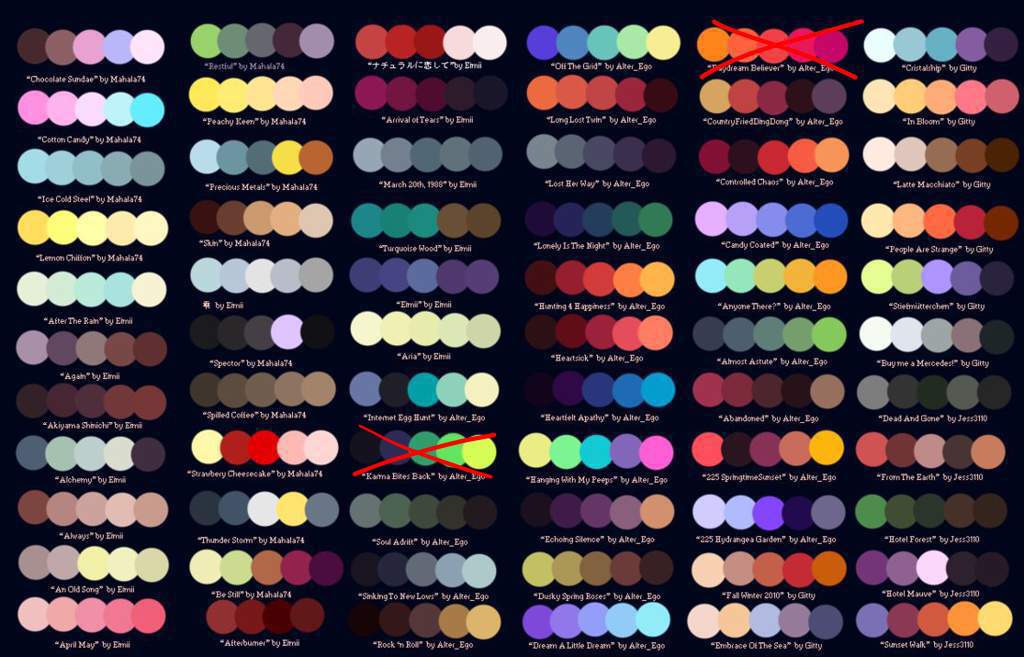FNAF color sheets have exploded in popularity across online communities, showcasing a vibrant evolution of artistic styles and character interpretations. From simple, cartoonish designs to highly detailed, realistic renderings, these sheets reflect the diverse creativity of the Five Nights at Freddy’s fanbase. This exploration delves into the trends, color palettes, technical aspects, community contributions, and even commercial applications of these digital artworks.
This article analyzes the various factors contributing to the success of FNAF color sheets, including the impact of character popularity, the effective use of color theory to evoke specific emotions, and the different software and techniques employed by artists. We’ll examine the legal and ethical considerations surrounding commercial use and showcase a selection of exceptional fan-made artwork, highlighting the range of artistic styles and interpretations within the community.
Five Nights at Freddy’s Color Sheets: A Deep Dive into Popularity, Design, and Community Impact: Fnaf Color Sheets
Five Nights at Freddy’s (FNAF) color sheets have become a significant phenomenon within the online art community and beyond. Their popularity spans various platforms, reflecting the enduring appeal of the FNAF franchise and the creative expression of its passionate fanbase. This analysis delves into the trends, design elements, technical aspects, community involvement, and commercial applications of these digital coloring pages.
Popularity and Trends of FNAF Color Sheets
FNAF color sheets enjoy widespread popularity across platforms like DeviantArt, Pinterest, Tumblr, and Reddit. Their prevalence is evidenced by the sheer volume of shared artwork, fan-created resources, and dedicated online communities. The evolution of FNAF color sheet designs reflects the franchise’s own stylistic changes over time. Early color sheets often mirrored the game’s original, somewhat simplistic art style. More recently, there’s been a noticeable shift towards more detailed and realistic depictions, incorporating intricate shading and textural elements.
Different artistic styles, ranging from cartoonish and minimalist to hyperrealistic and detailed, coexist, catering to diverse preferences within the fanbase.
Character popularity significantly impacts the frequency of their appearance in color sheets. Freddy Fazbear, Bonnie, Chica, and Foxy consistently rank among the most frequently featured characters, while less prominent characters might appear less often. This reflects the established hierarchy of characters within the FNAF lore and the fanbase’s individual preferences.
Analysis of Color Palette Choices in FNAF Color Sheets

Source: redd.it
Color palette choices play a crucial role in conveying character emotions and personalities within FNAF color sheets. For example, using muted browns and greys for withered animatronics can effectively communicate decay and a sense of foreboding, while brighter, more saturated colors might be used to depict the more cheerful or less sinister characters. The use of color theory is evident in many FNAF color sheets, with artists employing complementary colors to create visual interest or analogous colors to establish a unified mood.
For instance, the use of contrasting colors like purple and yellow might be used to highlight specific features or create visual tension. Conversely, using analogous colors such as shades of blue and green might create a calm and serene atmosphere.
A new color palette for the character Springtrap could incorporate desaturated greens and browns to emphasize his decaying state, with touches of rusty orange to highlight the metallic elements of his design. This would visually represent his aged, dilapidated condition while still retaining elements of his original design.
Technical Aspects of FNAF Color Sheets
FNAF color sheets are commonly available in various file formats, including PNG (for lossless image quality), JPG (for smaller file sizes), and PDF (for printing). The resolution and quality are critical considerations; higher resolutions are necessary for high-quality printing, while lower resolutions might suffice for online use. Software like Adobe Photoshop, GIMP (GNU Image Manipulation Program), and Krita are frequently employed to create and edit FNAF color sheets.
These programs offer a range of tools for drawing, coloring, and adding special effects.
Designing a simple FNAF color sheet using GIMP involves several steps:
| Step | Action |
|---|---|
| 1 | Open GIMP |
| 2 | Create a new file with desired dimensions and resolution. |
| 3 | Sketch the Artikel of the FNAF character. |
| 4 | Use the fill tool to add base colors. |
| 5 | Add shading and highlights using layers and blending modes. |
| 6 | Refine details and add textures as needed. |
| 7 | Save the file in the desired format (e.g., PNG). |
Community and Fan Involvement with FNAF Color Sheets
Fan-made FNAF color sheets significantly contribute to the game’s online community, providing a creative outlet for fans and fostering a sense of shared creativity. Common themes include recreating iconic scenes from the games, depicting characters in various poses or outfits, and exploring alternative interpretations of character designs. While official FNAF art often focuses on a specific style and aesthetic, fan-made color sheets exhibit a much wider range of artistic styles and interpretations, showcasing the diverse talent and perspectives within the fanbase.
- Example 1: A detailed, realistic style focusing on character textures and intricate details, creating a hyperrealistic depiction of a character like Springtrap’s decaying body.
- Example 2: A simple, cartoonish style emphasizing bold colors and simplified shapes, providing a playful take on characters like Chica.
- Example 3: A stylized, minimalist approach focusing on clean lines and limited color palettes, creating a unique aesthetic interpretation of Freddy Fazbear.
Commercial Applications of FNAF Color Sheets
FNAF color sheets find commercial applications in various merchandise, including coloring books, sticker sheets, and printable activity sheets. However, legal and ethical considerations must be addressed. Using copyrighted characters without permission is infringement. Successful commercial applications often involve obtaining official licenses or creating original designs inspired by FNAF but not directly copying existing characters. A hypothetical coloring book featuring original FNAF-inspired animatronics with unique designs and color palettes could target a broad audience, appealing to both FNAF fans and children interested in creative activities.
FNAF color sheets are a popular resource for fans, offering a detailed look at the game’s iconic characters. However, for those seeking a different kind of creative outlet, consider disconnecting from digital distractions and embracing nature at the off grid living festival camping event. Perhaps inspired by the vibrant colors found in the FNAF universe, attendees might find new ways to express their artistic side through nature-based activities.
Closing Notes

Source: narvii.com
FNAF color sheets represent more than just digital artwork; they’re a testament to the enduring appeal of the Five Nights at Freddy’s franchise and the boundless creativity of its fanbase. From simple coloring pages to complex, commercially viable designs, these sheets demonstrate the power of collaborative art and the potential for fan-created content to significantly impact a franchise’s cultural landscape.
The diverse styles and interpretations showcase the rich tapestry of artistic talent within the FNAF community, continually evolving and inspiring new creative endeavors.
